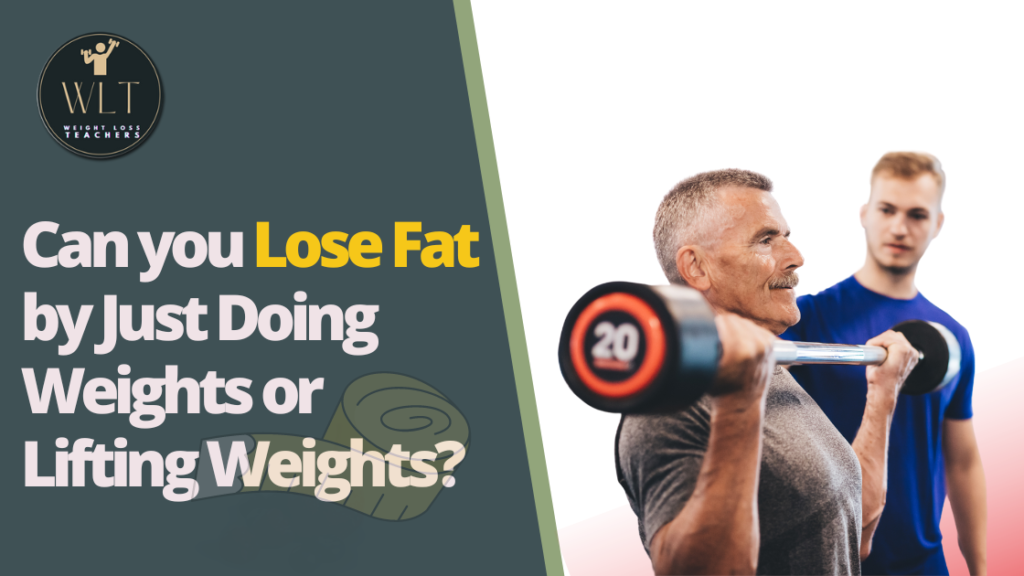
Can you Lose Fat by Just Doing Weights or Lifting Weights?

In the pursuit of a fit and healthy body, losing excess fat is a common goal for many individuals. While cardio exercises are often considered the primary choice for fat loss, there is a misconception that weightlifting alone cannot significantly contribute to shedding unwanted pounds.
Table of Contents
Can you Lose Fat by Just Doing Weights or Lifting Weights?
In this article, we will delve into the physiological mechanisms behind weightlifting, its impact on fat loss, and how it can be incorporated into an effective weight loss program. We will explore the science behind weightlifting’s ability to boost metabolism, increase muscle mass, and optimize fat loss, debunking the myth that weightlifting is not effective for fat loss.
Understanding Fat Loss and Weightlifting

To comprehend the relationship between weightlifting and fat loss, it’s crucial to understand the fundamentals of fat loss itself. Fat loss occurs when the body is in a calorie deficit, meaning it burns more calories than it consumes. This deficit can be achieved through a combination of diet and exercise.
Weightlifting, also known as resistance training, involves using external resistance, such as dumbbells or barbells, to challenge the muscles. The primary goal of weightlifting is to build muscle strength, size, and endurance. While cardio exercises predominantly focus on burning calories during the activity, weightlifting offers a unique advantage by stimulating muscle growth and increasing the metabolic rate even at rest.
Metabolic Impact of Weightlifting

Weightlifting plays a vital role in promoting fat loss by increasing the body’s metabolic rate. This increase occurs due to the energy demands placed on the muscles during resistance training. Weightlifting causes micro-trauma to the muscle fibers, which prompts the body to repair and rebuild them, resulting in muscle growth and increased metabolism.
Muscles are metabolically active tissues that require more energy to function compared to fat. By increasing muscle mass through weightlifting, the body’s resting metabolic rate (RMR) increases. RMR refers to the number of calories the body burns at rest to sustain basic physiological functions. With a higher RMR, individuals burn more calories throughout the day, including during periods of inactivity.
Furthermore, weightlifting stimulates the production of anabolic hormones, such as testosterone and growth hormone, which contribute to muscle growth and fat loss. These hormones not only aid in building lean muscle but also play a role in regulating the body’s metabolism and fat-burning processes.
Combining Weightlifting with Cardio

While weightlifting alone can contribute significantly to fat loss, combining it with cardio exercises can optimize results. Cardio exercises, such as running, cycling, or swimming, elevate heart rate and burn calories more rapidly. The synergistic effect of weightlifting and cardio enhances overall fat loss by targeting different energy systems and muscle groups.
Cardio exercises are effective for burning a significant number of calories during the workout, while weightlifting provides long-term benefits by increasing lean muscle mass and metabolic rate. By combining both types of exercise, individuals can create a well-rounded workout routine that maximizes fat loss and preserves muscle mass.
Incorporating weightlifting and cardio into a weekly exercise routine allows for variety, preventing plateaus and ensuring continuous progress in fat loss efforts. For example, alternating weightlifting and cardio workouts on different days or incorporating circuit training that combines both types of exercises can be highly effective.
Diet and Weightlifting

Although weightlifting plays a crucial role in fat loss, it is essential to emphasize the significance of a balanced diet. To lose fat, creating a calorie deficit is key. This can be achieved through a combination of reducing calorie intake and increasing calorie expenditure through exercise.
While weightlifting burns calories during the workout and boosts metabolism, it is important to fuel the body adequately for optimal performance and muscle recovery. A balanced diet rich in whole grains, lean proteins, fruits, and vegetables provides the necessary nutrients for muscle growth and repair. It is also important to consume an appropriate amount of protein to support muscle development.
Protein, in particular, is essential for weightlifters as it provides the building blocks for muscle repair and growth. Including lean sources of protein such as chicken, fish, tofu, and beans in your diet can help optimize the benefits of weightlifting for fat loss. Additionally, staying hydrated and consuming a variety of micronutrients through a well-rounded diet will support overall health and wellbeing.
It’s worth noting that weightlifting can have an impact on body composition beyond simply losing fat. By increasing muscle mass and reducing body fat, weightlifting can help create a more sculpted and toned physique. This is especially important for individuals who are looking to achieve a lean and athletic appearance.
Creating an Effective Weight Loss Program

To create an effective weight loss program centered around weightlifting, it’s essential to consider a few key factors. Firstly, determine your specific fat loss goals and establish a realistic timeline for achieving them. Set measurable targets, such as the amount of weight you want to lose or the reduction in body fat percentage you aim to achieve.
Next, design a workout routine that incorporates weightlifting exercises targeting all major muscle groups. Aim for a combination of compound exercises, such as squats, deadlifts, and bench presses, which engage multiple muscle groups simultaneously, and isolation exercises that target specific muscles.
Gradually increase the intensity and resistance of your weightlifting workouts over time. This progressive overload principle ensures that your muscles are continually challenged, leading to further growth and fat loss. It’s essential to maintain proper form and technique during weightlifting exercises to minimize the risk of injury and maximize the effectiveness of each movement.
In addition to weightlifting, include cardiovascular exercises in your routine. This can be achieved through activities such as jogging, cycling, swimming, or high-intensity interval training (HIIT). Aim for at least 150 minutes of moderate-intensity cardio or 75 minutes of vigorous-intensity cardio per week, in line with the recommendations from health authorities.
Lastly, prioritize recovery and rest days. Giving your body sufficient time to recover is crucial for muscle repair and growth. Adequate sleep, proper nutrition, and active recovery techniques, such as stretching and foam rolling, can aid in the recovery process and prevent overtraining.
Monitoring Progress and Adjusting Accordingly (Word count: 250) Tracking your progress is essential to determine the effectiveness of your weightlifting and fat loss efforts. Consider regularly measuring your body weight, body fat percentage, and taking progress photos to visually assess changes in your physique. Additionally, keeping a workout journal to record the exercises, sets, and reps performed can help monitor progress and make adjustments to your training routine.
If you find that progress has plateaued or you’re not achieving the desired fat loss results, consider making adjustments to your program. This may involve modifying the intensity, volume, or frequency of your weightlifting workouts, incorporating different exercises, or reassessing your dietary intake to ensure you are still in a calorie deficit.
Conclusion
Contrary to popular belief, weightlifting alone can significantly contribute to fat loss. Through its impact on metabolism, muscle growth, and hormone regulation, weightlifting plays a crucial role in creating a calorie deficit and promoting fat loss. By combining weightlifting with cardio exercises and maintaining a balanced diet, individuals can optimize their fat loss efforts and achieve a fit, healthy, and toned physique.
Disclaimer: The information provided in this article is for educational purposes only and should not be considered as a substitute for medical advice. Consult a healthcare professional before implementing any home remedies or making significant changes to your lifestyle.






